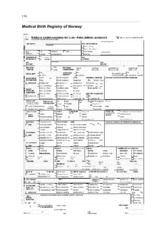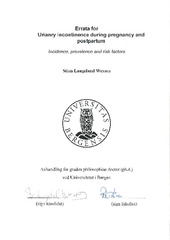| dc.contributor.author | Wesnes, Stian Langeland | en_US |
| dc.date.accessioned | 2013-12-09T14:41:11Z | |
| dc.date.available | 2013-12-09T14:41:11Z | |
| dc.date.issued | 2011-10-26 | eng |
| dc.identifier.isbn | 978-82-308-1856-5 | en_US |
| dc.identifier.uri | https://hdl.handle.net/1956/7584 | |
| dc.description.abstract | Urinary incontinence (UI) is a common condition among women. The prevalence of UI is high both during and after pregnancy, and childbearing is an established risk factor for UI among young and middle-aged women. However, incidence and prevalence estimates of UI in association with pregnancy vary widely. Only a few population based studies have investigated prevalence of UI in pregnancy by type and severity. Data are inconsistent regarding several risk factors for UI in pregnancy. UI starting before or in pregnancy is likely to predict UI postpartum. The role of incident UI in pregnancy has received little attention as a predictor for UI postpartum and later in life. Few authors have studied the effect of delivery mode on UI among primiparous women. Weight gain in pregnancy is thought to contribute to the increased prevalence of UI during and after pregnancy, but scientific support is lacking. The effect of weight loss on UI postpartum is unclear. The data collection for the current study was conducted as part of the Norwegian Mother and Child Cohort Study (MoBa) at the Norwegian Institute of Public Health. From 1999 to 2009, investigators in MoBa invited all pregnant women in Norway to participate in the study 2 weeks before the routine pregnancy ultrasound examination, aiming at a study population of 100,000 pregnant women. Our sub studies are based on available data at the time from this study population. The MoBa study was comprehensive, obtaining data by questionnaires of 14–18 pages length at seven time points from week 15 in pregnancy to 7 years after birth. We used questionnaire data from Questionnaire 1 received in week 15 of pregnancy, Questionnaire 3 received in week 30 and Questionnaire 4 received six months postpartum. In Paper I we used data obtained from 43,279 women who had answered Questionnaire 3. The study showed that the prevalence of UI increased from 26% before pregnancy to 58% in week 30. The corresponding figures for nulliparous women were 15% and 48%, and for parous women 35% and 67%. The cumulative incidence was 46%. Stress UI was the most common type of UI in week 30 of pregnancy. Before and in pregnancy the majority of pregnant women leaked less than once per week and droplets only. Parity was a strong and significant risk factor for UI in adjusted analyses both before pregnancy (OR 3.3, 95% CI 3.1–3.5) and in pregnancy (OR 2.1, 95% CI 2.0 –2.2) among parous women compared to nulliparous women. Increasing age and BMI were weaker, but still statistically significant, risk factors. In Paper II we selected nulliparous women who were continent before pregnancy and who had answered Questionnaire 1, 3 and 4 from the above dataset; at total of 12,679 women. Results were stratified for mode of delivery and continence status in pregnancy. UI was reported by 31% of the women 6 months after delivery. Compared with women who were continent in pregnancy, UI was more prevalent 6 months after delivery among women who were incontinent in pregnancy (adjusted RR 2.3, 95% CI 2.2–2.4). Adjusted RR for UI after SVD compared with elective CS was 3.2 (95% CI 2.2–4.7) among women who were continent and 2.9 (95% CI 2.3–3.4) among women who were incontinent in pregnancy. In Paper III we used the same dataset as in Paper II. We found that weight gain > 50th percentile during weeks 0–15 of pregnancy was weakly associated with higher incidence of UI at week 30 compared with weight gain ≤ 50th percentile. Weight gain > 50th percentile in pregnancy was not associated with increased prevalence of UI 6 months postpartum. Weight gain > 50th percentile from the start of pregnancy to 6 months postpartum was more strongly associated with having UI 6 months postpartum than was high weight gain in any single sub period. Each kilogram of weight gain in this time period increased the RR for UI by 2.3% (RR 1.02, 95% CI 1.02–1.03). From delivery to 6 months postpartum, there was a clear association between weight loss and lower prevalence of UI among women who were continent and as well as those among those who were incontinent in pregnancy. For each kilogram of weight loss among all women who were incontinent in pregnancy, the relative risk for UI decreased by 2.1% (RR 0.98, 95% CI 0.97-0.99). Main findings in the thesis: The prevalence of UI was high before pregnancy. Prevalence increased substantially in pregnancy and was reduced postpartum. Prevalence of UI postpartum was, however, higher than before pregnancy. UI in pregnancy was associated with UI postpartum. Vaginal delivery was a strong independent risk factor for UI postpartum. The association between UI postpartum and mode of delivery was not significantly influenced by incontinence status in pregnancy. Prediction of a group with high risk of incontinence postpartum by mode of delivery cannot be based on continence status in pregnancy. Weight gain in the beginning of pregnancy was weakly associated with UI in pregnancy. The association is not likely to be of clinical importance as the weight gain in beginning of pregnancy was not associated with UI postpartum. Weight loss postpartum seemed to have an impact in avoiding UI and regaining continence 6 months postpartum. | en_US |
| dc.language.iso | eng | eng |
| dc.publisher | The University of Bergen | eng |
| dc.relation.haspart | Paper I: Wesnes SL, Rortveit G, Bo K, Hunskaar S. 2007. Urinary incontinence in pregnancy. Obstet Gynecol 109: 922 – 928. The article is available at: <a href="http://hdl.handle.net/1956/7588" target="blank">http://hdl.handle.net/1956/7588</a> | en_US |
| dc.relation.haspart | Paper II: Wesnes SL, Hunskaar S, Bo K, Rortveit G. 2009. The effect of urinary incontinence status during pregnancy and delivery mode on incontinence postpartum. A cohort study. BJOG 116: 700 – 707. The article is available at: <a href="http://hdl.handle.net/1956/7589" target="blank">http://hdl.handle.net/1956/7589</a> | en_US |
| dc.relation.haspart | Paper III: Wesnes SL, Hunskaar S, Bo K, Rortveit G. 2010. Urinary incontinence and weight gain in pregnancy: a cohort study. Am J Epidemiol 172: 1034 – 1044. The article is available at: <a href="http://hdl.handle.net/1956/7590" target="blank">http://hdl.handle.net/1956/7590</a> | en_US |
| dc.title | Urinary incontinence in pregnancy and postpartum. Incidence, prevalence and risk factors | en_US |
| dc.type | Doctoral thesis | |
| dc.rights.holder | Copyright the author. All rights reserved | |


